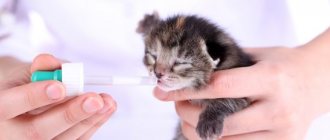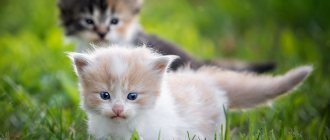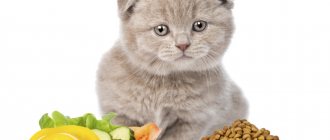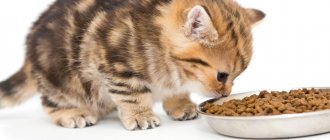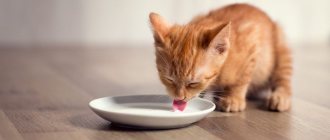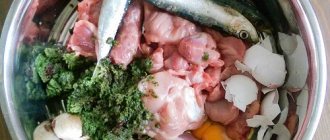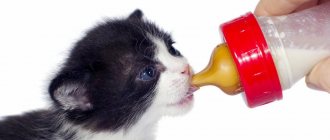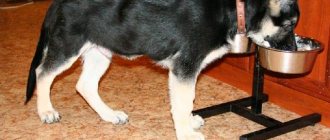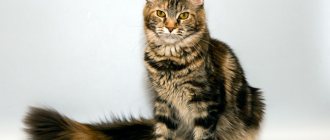There is nothing more nutritious and beneficial for a child’s body than mother’s milk. Despite this fact, some circumstances oblige the owner to look for alternative feeding methods. He has to find out on his own what and how many times he can feed a kitten at 1 month, so as not to harm the baby. By following the rules for introducing complementary foods and excluding prohibited foods, you can easily raise a healthy and strong pet on your own.
At 1 month
Below we will look at how and what to feed a 1 month old kitten at home:
- dry mixtures (sold in pet departments);
- fermented milk products (with low fat content and without sugar);
- goat milk (dilution with water is appropriate: 1:1);
- liquid porridge (semolina or rice, preferably crushed);
- yolk (boiled, mixed with low-fat cottage cheese; allowed 2 times every 7 days);
- puree for children: meat or fish;
- soup (low-fat meat + broth, no need to salt it. Allowed once every 7 days);
- fish (sea fish, boneless fillets are best. Give 2 times every 7 days).
Allowed foods are introduced into the kitten’s menu gradually so that the baby gets used to the new diet. If you do not take this into account, the baby may develop diarrhea, indigestion, and what’s even worse, the kitten may die.
How to feed a one-month-old kitten
Newborn kittens rarely drink water, but they need liquid nutrition (take 10% fat cream - you definitely can’t go wrong). There should always be a bowl of clean water next to your food, which needs to be changed regularly. Make it a rule to wash his bowl after every meal, cats are clean creatures, your kitten will not like a dirty bowl. It is best to take not plastic, but metal.
Up to 1 month, feed the kitten 8 times a day. The number of meals is gradually reduced as the pet gets older. If the baby refuses to eat, do not delay visiting the veterinarian.
At the age of 4 months, give the kitten 50g. food at a time (per 100 g of weight). The normal weight of a small kitten is 200 g; 100 g of food per day will be enough for him.
Can I have milk?
Veterinarians advise giving the kitten instant powder (instead of milk). Cow's milk, which contains lactose, is not the best food for your pet. The powder is sold in any pet department. After 1 month, feed the kitten milk 2 times a day. If you have adopted a kitten that is accustomed to milk, give it a product in porridge form that contains lactose.
You can feed your pet:
- fermented baked milk;
- sour cream.
These products contain many useful substances and cats love them.
Getting used to solid food
Young kittens are gradually introduced to solid food. Veterinarians advise taking into account the kitten’s nutrition: if you plan to feed it meat, you can cut small pieces of fillet and add them to the broth; if the baby eats liquid porridge, you can gradually dilute it and add more solid foods, for example, cereal.
While kittens readily eat meat, not all of them appreciate vegetables. A kitten accustomed to liquid food will have a harder time getting used to solid food - stay nearby and supervise your pet’s nutrition.
If your pet leaves pieces of solid food in the bowl, grind them in a blender or chop them as finely as possible.
Products recommended for nutrition
The first solid food should be soft. You can't give your kitten a piece of fish - he just won't be able to eat it. You can mix raw yolk with dairy products. If you decide to cook it, mix it with milk. Some owners add vegetable oil (without this, the baby may choke, as they believe).
https://youtu.be/BLriBLfbjCA
Getting your kitten used to solid food
With the appearance of baby teeth, you can diversify your diet with solid foods. Instead of minced meat, offer your pet finely chopped meat and fish pieces. Use only low-fat varieties, not forgetting about pre-freezing and cooking. Two-stage treatment at different temperatures will eliminate infection by parasites.
Gradually reduce the amount of liquid in porridges by adding meat to them. The baby quickly gets used to this additive in broths and cereals, but you will have to tinker with the individual serving of meat. If the pieces remain in the bowl, then try grinding them into minced meat and offering them again. Having become accustomed to the smell and taste, the cat will begin to eat meat in larger quantities.
At 1.5 months
Below we will consider how and what to feed a 1.5 month old kitten at home:
At this age, the pet can already feed on its own, and its diet should be balanced. At this age, the kitten can be fed:
- rolled oats and buckwheat porridges;
- vegetables (any vegetables, except potatoes, served boiled or raw);
- raw meat (low-fat varieties). Served raw, boiled or scalded with boiling water. Meat products make up from 60 to 80% of the total daily food volume.;
- boiled offal;
- cottage cheese - 30 g per day, preferably not fatty;
- raw fish, previously doused with boiling water (about 1 time every 7 days);
- greens (you can ask at the animal department).
How often should I feed?
Kids eat a lot, 5-6 meals a day is the norm. In general, a kitten should eat 120 g per day. The baby cannot eat this amount at once. If the kitten eats less than normal, then you should try changing the food. If the animal refuses food, it is better to contact a veterinarian.
Once the kitten reaches 2 months, you can feed it a little more - up to 180 g. At this point, it is important to monitor the pet’s activity - more playful and active ones need more food.
If you are going away for the day and leaving your kitten alone, feed him before you leave and leave some food in his bowl and feed him more when you return.
Food additives
Do not neglect this important point - vitamins and supplements will have a beneficial effect on the kitten’s body.
From 1.5 months you can add to food:
- Kitzim;
- "Doctor Zoo";
- "Brevers";
- "Farmavit";
- "Biofar".
Before purchasing vitamins, consult with specialists. Veterinarians can advise you on which food supplements are best for your pet and whether your pet needs them at all. The most popular supplement for cats is fish oil. Veterinarians advise giving it 2 capsules for 7 days.
What not to give to a kitten
Every caring owner should remember the list of prohibited foods. Kittens should not eat:
- food with spices (the kind that people like);
- fatty meat: pork, beef;
- human medicines;
- sweets;
- river fish;
- legumes;
- fatty dairy products;
- flour;
- potatoes.
Is it possible to have ready-made food at 1.5 months?
Cat owners and veterinarians do not recommend mixing food and natural food. Many people primarily purchase ready-made cat food for a number of reasons:
- saving time;
- nutritional balance.
If you want to feed your pet food, you should consider that:
- it will not be possible to switch to natural nutrition;
- You cannot mix food of different brands, as they contain different microelements;
- Only high-quality commercial feed is suitable for feeding.
Choose high-quality, balanced food and your kitten will not have any health problems.
Kittens love wet food, but it's a little more expensive. However, according to veterinarians, dry, high-quality ones are more useful.
It is worth noting that wet food contains about 80% water, and your pet does not need to constantly drink water. With dry food, everything is different - there should always be a clean bowl with drinking clean water near the food bowl.
Veterinarians consider the following brands to be good food:
- Royal Canin;
- Almo Nature;
- Pro Plan Junior;
- Eukanuba Puppy Kitten.
The price tag may scare the kitten's owners, but believe me, by purchasing good food, you only win. You won’t have to buy additional vitamins, and the kitten will be healthy, and you won’t have to spend money on treatment.
Selecting a diet for a one-month-old kitten
global $ads_google; //data-ad-slot=”2475549904″ $ads_google = empty($ads_google) ? false : true; ?> if ($ads_google == false) {?>
$ads_google = true; ?> } ?>
To choose the right diet for a 1-month-old kitten, you need to find out what you can feed it and how often to feed it. Among cat lovers, there is ongoing debate about what is better - natural food or ready-made food. To solve this problem, you need to proceed from what the future cat needs in order for it to grow up healthy, beautiful and strong. Manufacturers of dry food produce products designed for a specific age of a pet and the requirements of its body. Proponents of natural food also turn out to be right: all useful substances can be obtained from natural nutrition. In order not to make a mistake, you will have to make a choice in favor of one type of food or another - you cannot mix them.
Features of feeding cats of different breeds
There are no main differences in food; cats are predators; periodically all breeds are given meat or fish. But there are minor differences: for example, British Shorthairs are fed nutritious food - they grow quickly and need more abundant nutrition. Russian blue cats should not be given liver, and the Maine Coon needs plentiful and dense nutrition (the main thing is not to overfeed).
Ready-made feed
Various brands of ready-made cat food vying with each other to praise their products. The main thing here is not to get lost in bright advertising. Let us agree that we consider only high-quality premium and super-premium food.
If you need to feed a 1-month-old kitten, then turn to brands such as:
- Royal canin
- Akana
- Almo Nature
- Purina Pro Plan
- Nero Gold
- Arden Grange
The manufacturer has already worried in advance, completed all the calculations and offers ready-to-eat food. Experts have no doubt about the quality of food from Royal Canin with the prefix “super”. The taste variety will be received with a bang by the baby.
Akana food for kittens comes in three flavors that can be alternated. There is no dye in this product, which eliminates the possibility of digestive problems.
Almo Nature is also suitable for a one-month-old cat and consists mainly of high-quality chicken meat and non-allergenic rice.
Frequency of feeding kittens depending on age
- In the first 14 days of life - 10 meals;
- From two weeks to one month, reduced to 8 meals;
- By two months they switch to feeding 7 times a day;
- From the 2nd to the 3rd month they feed 6 times;
- From 4 to 5 – 5 times; From 5 to 9 – 4 times;
- From 9 to 12 – 3 times;
- After a year they switch to two feedings a day.
Little kittens still drink the milk of their mother cat, and what kind of complementary feeding you organize for them depends on your wishes. If complementary feeding consists of natural food, continue to feed it; if it’s food, then food. Do not mix 2 different types of food, this is incorrect and can harm your pet's health.
Forbidden food
Do not forget that any food from the human table is contraindicated for pets. Stop any attempts by compassionate relatives to feed your “unlucky” pet pickles, sweets, herbs, smoked meats, flour, fried and fatty foods. A moment's pleasure can turn into a long and expensive treatment.
In addition to the foods listed, avoid feeding:
- pearl barley and millet;
- sorrel, onion and garlic;
- any bones;
- pork;
- mushrooms and potatoes;
- raisins and grapes;
- legumes
Don't believe the myths about the benefits of milk and fish. After a year, cats develop lactose intolerance, accompanied by diarrhea and increased gas production. Fish is fraught with the development of urolithiasis and kidney inflammation, so it is also better to avoid its frequent consumption.
Useful video
Get to know interesting cat breeds with the help of our encyclopedia: Burmese, Himalayan, Javan.
What not to feed cats
What grass do cats eat and why?
General information
Solid foods are introduced into the kitten's diet little by little and gradually. Solid foods include cheese and whole grain porridge. A small kitten can be fed egg yolk, it is given no more than twice a week. When feeding a small pet, we must not forget about vitamins and fiber. Add apples, cucumbers, and herbs to your animal's food.
If the animal cannot cope with pieces of whole vegetables, then grate them. Provided you follow all the above recommendations and receive vitamins, your kitten will develop healthy and strong.
What is needed to feed a kitten
To successfully feed a kitten without a cat, the following fundamental elements are necessary:
- nutrition - its composition and feeding regimen, as well as compliance with certain rules when feeding;
- temperature regime - kittens do not have the ability to effectively thermoregulate, and therefore they are susceptible to hypothermia;
- hygiene - kittens need assistance with urination and defecation; it is necessary to monitor the cleanliness of their fur and den.
Setting up a nest for a kitten left without a mother
The kitten needs a constant temperature regime, and external stimuli are also undesirable for it, so you should arrange a den for the baby:
- You can use a thick cardboard box or something else as a basis.
- Cover the bottom with dense thermal insulation material, for example, a blanket, and put a disposable diaper on top.
- Cover the top of the box with a warm woolen cloth.
A den for kittens should be warm and safe.
You can place a soft fluffy toy in the kitten's box.
Temperature
Maintaining the desired temperature in the den is possible using:
- incandescent lamps placed above the den;
- bottles of hot water, tightly closed and wrapped in a towel so as not to burn the kitten;
- regular heating pads, also covered with a towel.
When installing heating, it is important to leave one corner of the den free from it. The kitten will hide in this place if it gets hot.
Temperature:
- for the first week of a kitten’s life, the temperature of the den is maintained at 27–32 °C;
- second week - 27–29 °C;
- During the third and fourth weeks, the temperature is successively lowered so that by the end of the 4th week it reaches 24 °C.
Necessary items for feeding
To feed a kitten you will need:
- bottles for formula milk;
- nipples;
A bottle for kittens with nipples is sold in a veterinary pharmacy
- an alternative to a bottle with a nipple: a syringe without a needle - it is convenient to dose the mixture, which can be fed directly from the syringe;
- soft catheters with side holes, they are put on a syringe and used for feeding kittens;
- plastic bottles with medicine pipettes, very thoroughly washed;
Feeding rules
When feeding, keep in mind that:
- the mixture should be warm, you can check this by dropping a drop on the bend of your elbow or wrist, the optimal temperature of the mixture is 38 ° C;
- the remaining mixture can be stored in the refrigerator, but no more than a day;
- to prevent aspiration (fluid entering the kitten’s respiratory tract): avoid the use of kitten feeding devices with wide openings;
- the formula for feeding a kitten is not fed under pressure, the kitten sucks it itself, and the person only helps;
- when feeding, the kitten is positioned belly down;
Kittens are fed in a belly down position
Video: how to bottle feed a kitten
Kitten hygiene
The immunity of a kitten left without a cat is very weak. Therefore, the person who has taken responsibility for the baby must strictly adhere to the rules of care:
- For the first three weeks of a kitten's life, he needs to massage the abdomen and perianal area in order to induce urination and defecation. This is done using a damp linen napkin. Massage should be done after each feeding.
- The diaper the kitten is wearing must be dry and clean, and it must be changed more often (daily or when soiled).
- The skin of the kitten's abdomen is susceptible to irritation. To prevent it, wipe it with baby oil; if irritation occurs, use baby powder.
- They always prepare food for the kitten, and also feed and care for it only with clean hands and in clean clothes, in which there has been no contact with other cats, since a baby growing without a mother does not have colostral immunity, and it is not yet capable of producing its own antibodies.
Video: how to help a kitten go to the toilet
What should you not feed?
For newborn kittens the following are prohibited:
- Raw cow's milk, food is difficult to digest in the gastrointestinal tract of a tiny animal.
- Milk diluted with water and complementary foods are not nutritious enough; the baby does not receive the required amount of microelements and vitamins.
- Kefir, fermented baked milk, sour cream, yogurt, the baby’s stomach is not able to digest.
- Sausage, meat, cheese, and other products are harmful to the body of a newborn kitten.
- Minced fish, possible parasitic infection.
Is it possible to give milk?
Can kittens have milk? This is a question that worries many owners of furry pets. Veterinarians do not recommend giving it in its pure form, as it is difficult for the intestines. Regular milk may cause your kitten to vomit and become upset. Alternatively, you can buy baby formula. This product will not cause harm, but it will not be of great benefit either. Despite the fact that the composition contains nutrients and vitamins, they are not of particular value to the cat. It is better to purchase a milk replacer at a pet store. The price for such a product ranges from 300-500 rubles.
If you wish, you can prepare the mixture yourself. To do this, mix boiled milk with water (50:50), add half a fresh raw yolk and a teaspoon of corn oil. The prepared mixture must be served warm. If the product is cold, the kitten may refuse to eat.
If the animal cannot yet eat on its own, it must be fed from a pipette or syringe without a needle.
How to choose a milk replacer
Considering the unique composition of cat milk, veterinary substitutes that are close to it in nutritional content are best suited as a replacement. In addition to the main nutritional ingredients, high-quality milk substitutes contain:
- vitamins;
- microelements;
- taurine;
- minerals;
- polyunsaturated acids (omega-3; omega-6).
The following are usually referred to as reliable products:
- Beaphar Kitty-Milk;
- Royal Canin Babycat Milk;
- Gimpet Cat-Milk.
If it was not possible to buy a veterinary substitute, you can temporarily use baby formula used for feeding very young children, diluting it 2 times more than the instructions require.
Video: how to make a mixture for a kitten yourself
From six months to a year
Kittens between six months and one year of age are still growing. And it is no longer necessary for them to purchase special dry food for kittens. At what age should I switch to regular “adult” analogues? Not before all of the kitten's teeth are replaced. That is, at least from 6–7 months.
Teenage cats can be fed in the same way as adult cats. But until the animal is one year old, the diet should still contain more than just dry food. It is very important to feed your cat meat, fish, cottage cheese, vegetables and fruits. But giving whole milk is not recommended. This may result in an upset stomach.
